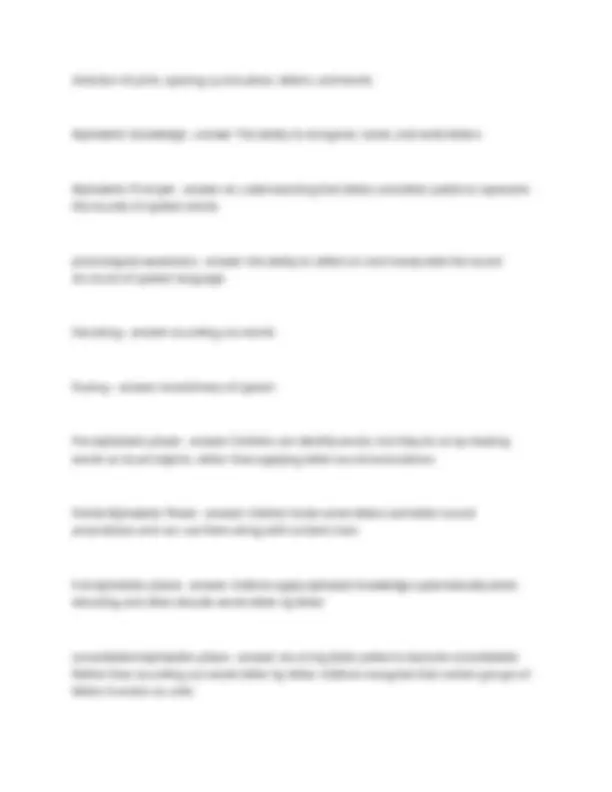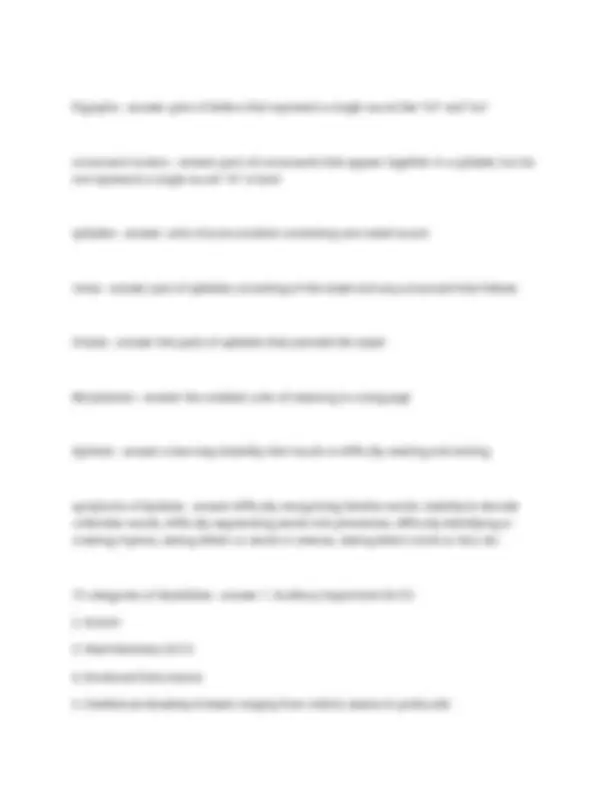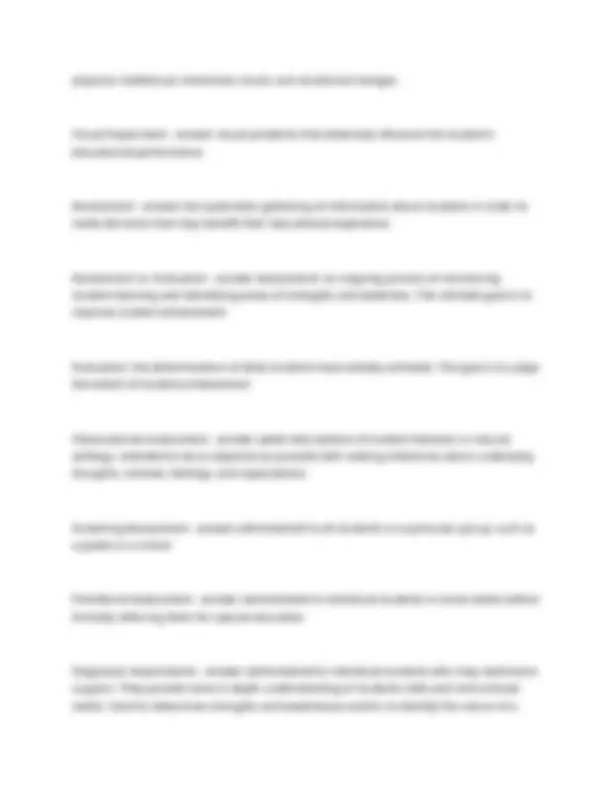








Study with the several resources on Docsity

Earn points by helping other students or get them with a premium plan


Prepare for your exams
Study with the several resources on Docsity

Earn points to download
Earn points by helping other students or get them with a premium plan
Community
Ask the community for help and clear up your study doubts
Discover the best universities in your country according to Docsity users
Free resources
Download our free guides on studying techniques, anxiety management strategies, and thesis advice from Docsity tutors
Students With Disabilities CST Exam Questions And Correct Answers.
Typology: Exams
1 / 12

This page cannot be seen from the preview
Don't miss anything!







mainstreaming - answer integrating students with disabilities or special needs into the overall educational program Individuals with Disabilities Improvement Act (IDEIA) - answer federal law that governs the education of children with disabilities Individuals with Disabilities Education Act (IDEA) - answer U.S. legislation granting educational rights to people with cognitive, emotional, or physical disabilities from birth until age 21; initially passed in 1975, it has been amended and reauthorized in 1997 and again in 2004. IDEA operates under six basic principles: zero reject, nondiscriminatory identification and evaluation, free and appropriate public education, least restrictive environment, due process, and parent and student participation in shared decision making with regard to educational planning. Child Find - answer A function of each state, mandated by federal law, to locate and refer individuals who might require special education Free Appropriate Public Education (FAPE) - answer Special education and related services that (a) have been provided at public expense, under public supervision and direction and without charge; (b) meet the standards of the state educational agency; (c) include an appropriate preschool, elementary, or secondary school education in the state involved; and (d) are provided in conformity with the individualized education program Least Restrictive Environment (LRE) - answer a legal requirement that children with special needs be assigned to the most general educational context in which they can be expected to learn Continuum of Services - answer matching the needs of the student with an appropriate placement on an individual basis Individualized Education Plan (IEP) - answer a legal document defining the educational program and related services for a specific student who has a disability Individualized Family Service Plan (IFSP) - answer a written document similar to an IEP that focuses on the family and the child's natural environment
Vocational Rehabilitation Act - answer prohibits discrimination on the basis of physical or mental disabilities Family Educational Rights and Privacy Act (FERPA) - answer helps ensure the privacy of educational records such as IEPs Every Student Succeeds Act (ESSA) - answer increases the accountability of schools with respect to the academic progress of students with disabilities Committee on Special Education (CSE) - answer stores student special education records, opens all initial referrals and assigns a CSE case number for public school students. The CSE also manages all special education issues for non-public schools (private, parochial) and charter schools Committee on Preschool Special Education (CPSE) - answer for children between the ages of 3 and 5 Procedural Safeguards - answer provisions of IDEA designed to protect students and parents in the special education process Due Process - answer refers to principles that attempt to guarantee the rights of citizens due process hearing - answer A procedure to resolve a conflict between school and family over the evaluation, program, or placement of a student with a disability age of majority - answer the designated age at which an individual is recognized as an adult prereferral assessment - answer to help students who are struggling in the general education setting before referring them for special education assessment Response to Intervention (RTI) - answer an educational strategy intended to help children who demonstrate below-average achievement in early grades, using special intervention self-reflection - answer the process of becoming aware of and analyzing one's own thoughts, feelings, and behaviors What Works Clearinghouse (WWC) - answer __________________ is an example of a US government website that provides information about scientifically based research of relevance to instructional practice. US Department of Education - answer A government agency that oversees education and federal student aid in the United States
direction of print, spacing, punctuation, letters, and words Alphabetic knowledge - answer The ability to recognize, name, and write letters Alphabetic Principle - answer an understanding that letters and letter patterns represent the sounds of spoken words phonological awareness - answer the ability to reflect on and manipulate the sound structure of spoken language Decoding - answer sounding out words fluency - answer smoothness of speech Pre-alphabetic phase - answer Children can identify words, but they do so by treating words as visual objects, rather than applying letter-sound associations Partial Alphabetic Phase - answer children know some letters and letter-sound associations and can use them along with context clues Full alphabetic phase - answer children apply alphabet knowledge systematically when decoding and often decode words letter by letter consolidated alphabetic phase - answer recurring letter patterns become consolidated. Rather than sounding out words letter by letter, children recognize that certain groups of letters function as units
Digraphs - answer pairs of letters that represent a single sound like "sh" and "oo" consonant clusters - answer pairs of consonants that appear together in a syllable, but do not represent a single sound "rk" in bark syllables - answer units of pronunciation containing one vowel sound rimes - answer part of syllables consisting of the vowel and any consonant that follows Onsets - answer the parts of syllables that precede the vowel Morphemes - answer the smallest units of meaning in a language dyslexia - answer a learning disability that results in difficulty reading and writing symptoms of dyslexia - answer difficulty recognizing familiar words, inability to decode unfamiliar words, difficulty segmenting words into phonemes, difficulty identifying or creating rhymes, seeing letters or words in reverse, seeing letters move or blur, etc. 13 categories of disabilities - answer 1. Auditory impairment (0-21)
hearing impairment - answer an impairment in hearing, whether permanent or fluctuating, that adversely affects a child's educational performance but is not included under the definition of "deafness." intellectual disability - answer refers to general intellectual ability that is significantly below average, combined with limitations in adaptive behavior, which adversely impacts the student's educational performance multiple disabilities - answer a combination of disabilities that is so severe the student cannot benefit from programs designed for any one of those disabilities Orthopedic Impairment (OI) - answer refers to musculoskeletal problems, congenital or adventitious, that adversely influence the student's educational performance. Ex: cerebral palsy, polio, and amputations Other Health Impairment (OHI) - answer refers to health problems affecting strength, energy, or alertness to a degree that adversely impacts the student's educational performance. Ex: leukemia, epilepsy, diabetes, asthma, lupus, and sickle cell anemia Specific Learning Disability - answer a disorder in one or more of the basic psychological processes involved in understanding or in using language, spoken or written, that may manifest itself in the imperfect ability to listen, think, speak, read, write, spell, or to do mathematical calculations. Ex: dyslexia, dyscalculia Speech or Language Impairment - answer a communication disorder such as stuttering, impaired articulation, a language impairment, or a voice impairment that adversely affects a child's educational performance Traumatic Brain Injury (TBI) - answer A traumatic insult to the brain capable of producing
physical, intellectual, emotional, social, and vocational changes. Visual Impairment - answer visual problems that adversely influence the student's educational performance Assessment - answer the systematic gathering of information about students in order to make decisions that may benefit their educational experience Assessment vs. Evaluation - answer Assessment: an ongoing process of monitoring student learning and identifying areas of strengths and weakness. The ultimate goal is to improve student achievement Evaluation: the determination of what students have already achieved. The goal is to judge the extent of student achievement Observational assessment - answer yields descriptions of student behavior in natural settings, intended to be as objective as possible with making inferences about underlying thoughts, motives, feelings, and expectations Screening Assessment - answer administered to all students in a particular group, such as a grade or a school Prereferral Assessment - answer administered to individual students in some states before formally referring them for special education Diagnostic Assessments - answer administered to individual students who may need extra support. They provide more in depth understanding of students skills and instructional needs. Used to determine strengths and weaknesses and/or to identify the nature of a
greater or lesser difficulty, to understand what contributes to these differences in functioning, and to draw useful implications for instructional planning authentic assessment - answer provided descriptions of student performance on real-life tasks carried out in real-world settings rubric - answer a guide to the evaluation of student work that provides definitions of different levels of performance portfolio - answer a collection of work produced by a student over time. The goal is to gauge student effort, progress, and achievement through examinations of many different kinds of work that the student has produced in a particular class or related to a specific theme norm-referenced assessment - answer provides results for an individual student that are related to norms; most results indicate the individual performance compared to others of the same age, they are standardized - WISC, Battelle Criterion-Referenced Assessment - answer Compares the individual's performance to some predetermined standard or criterion. individual-referenced assessment - answer used to compare an individual's score at one point with the same individual's score at a later point - running record New York State Alternative Assessment (NYSAA) - answer administered to students whom the CSE has designated as having severe cognitive disabilities. These students must be assessed by means of the NYSAA once per year, beginning at age 9 and continuing through age 14, in order to document their progress toward achieving the New York State learning standards and alternate grade-level indicators
Performance-based assessment - answer An alternative assessment method based on a student's performance of a skill based on a real-life situation. Validity - answer The ability of a test to measure what it is intended to measure Realibility - answer the consistency of assessment results Curriculum-Based Assessment - answer This is a particular type of criterion-referenced test in which the test items are taken from the curriculum being taught to the student. This type of test can provide information regarding how well the student is learning the curriculum being taught. Mediation - answer a meeting between parents and school represents conducted by a qualified, impartial mediator whose goal is to find a resolution that satisfies all parties manifestation determination review - answer meeting of IEP team with administrators and parents to determine whether a student's misbehavior is a manifestation of the student's disability, or whether it resulted from the school's failure to appropriately implement the IEP - applies to recurring or extreme behavior transition - answer intended to help prepare students with disabilities for life after their K- 12 education homogeneous groups - answer students are similar to each other in some respect heterogeneous group - answer students are different from each other in some important